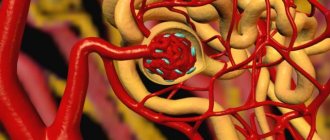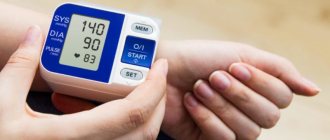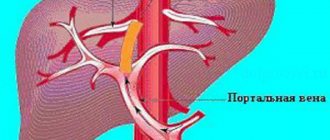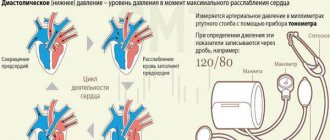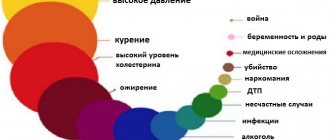Stage 2 hypertension is characterized by an increase in blood pressure to 160–179 per 100–109 mmHg. Art. If such numbers persist for a long time, and the patient is not provided with the necessary medical care or is provided incorrectly, the disease progresses, and dangerous complications may arise.
Hypertension of the second degree is diagnosed by blood pressure indicators - 160–179/100–109 mm Hg. Art.
What is it - stage 2 hypertension
Hypertension is characterized by persistent arterial hypertension, i.e. an increase in blood pressure above 130/80 mm Hg. Art. Depending on the level of excess of the norm, the degree of the disease is determined. The pathology occurs chronically, for many months or even years. In such long-term dynamics, it is difficult to notice the progression of the disease, but it occurs - slowly but surely the compensatory forces of the body are depleted, and the disease moves to the next stage.
Grade 2 means that the pressure fluctuates in the range of 160–179 mmHg. Art. for upper, systolic pressure, and 100–109 mm Hg. Art. diastolic. These are quite high numbers, so this diagnosis requires the prevention of hypertensive crises, lifestyle correction, regular blood pressure monitoring and drug therapy.
An important condition for the effectiveness of treatment is lifestyle modification - eliminating physical inactivity, giving up bad habits, excessive physical and mental stress, normalizing work and rest, healthy eating with limited salt intake.
Causes
Patients with stage 2 hypertension are more susceptible to all sorts of complications. The disease is in a borderline state before moving to stage 3 hypertension, which is severe and leads to serious health consequences. This must be avoided.
High blood pressure is caused by the following reasons:
- atherosclerosis (hardening, decreased elasticity of blood vessels);
- unbalanced diet, obesity;
- heredity (genetic predisposition);
- sedentary lifestyle;
- bad habits (alcohol, smoking);
- vascular pathologies;
- prolonged emotional stress (stress);
- hormonal imbalances (especially during the premenopausal period in women);
- kidney problems;
- tumors;
- endocrine pathologies;
- fluid retention in the body;
- failures of the genitourinary system.
The rhythm of modern life with its stress and accelerated pace initially causes small pressure surges (by 20-40 units). But due to the need to adapt to increased workload and live in high blood pressure, all human organs and systems suffer: the heart, blood vessels, brain, lungs. The risks of strokes, heart attacks, pulmonary edema and other serious consequences increase.
Arterial hypertension 2 causes the following risks:
- deterioration of general condition;
- loss of normal brain function;
- causing harm to organs that suffer more than others from high blood pressure or its changes.
The following factors also complicate the clinical picture of the disease: age (men over 55, women over 65), high blood cholesterol, long-term smoking, diabetes, hereditary predisposition, metabolic disorders.
Over 10 years, hypertension 1 causes 15% damage to organ function.
If a patient is diagnosed with hypertension in the third stage, this indicates that the process is advanced. Often, when the first symptoms appear, patients self-medicate and normalize blood pressure with random medications. They don't even suspect that the process has already started.
The second stage causes concern and is the reason for a visit to a specialist. But even this experience does not always force you to adhere to the doctor’s recommendations. The dosages of medications and the regimen are violated. Recommendations regarding changing the diet and giving up bad habits are ignored.
The development of stage 3 hypertension does not occur at lightning speed.
The diagnosis of “arterial hypertension stage 2, risk 2” usually comes with age, because the body wears out, the lumens in the vessels narrow and blood circulation becomes difficult. But in recent years, this diagnosis has been made to patients just over 30 years old, and, what is more surprising, even very young people can find some symptoms of this disease.
Why is the pressure unstable, what causes such high numbers?
- Atherosclerosis: because of it, blood vessels lose their elasticity and the lumens in the arteries narrow.
- Hereditary factors and genetic predispositions.
- Bad habits: smoking and alcohol.
- Lifestyle: People move too little.
- High body weight.
- Increased blood sugar, hormonal changes in the thyroid gland.
- Kidney diseases.
- Stressful situations.
- Excessive salt intake causes water retention in the body.
In addition to the presence of the underlying disease, predisposing factors can be noted:
- Heredity.
- Overweight.
- Metabolic disorders.
- Abuse of alcoholic beverages and smoking.
- Fluid retention in the body due to consumption of large amounts of salt.
- Mental disorders, stress, depression.
- Sedentary lifestyle.
- Lifting excessive weights.
Hypertension stage 2: risk No. 2, No. 3
In medicine, it is customary to divide diseases according to the degree of their ability to cause complications, that is, according to risks. At the same time, the likelihood and degree of damage to the brain, kidneys, blood vessels and factors that aggravate the situation are assessed. So, aggravating criteria:
- Age: over 50 years.
- Cholesterol level: over 6.5 mmol/1 liter of blood.
- Diabetes.
- Smoking.
- Drinking alcoholic beverages.
- Heredity.
Risk 2 with stage 2 hypertension is about 20% of the chance of getting a complication over 10 years. Therefore, the severity is moderate. The diagnosis is established in the absence of stroke and abnormalities in the endocrine system.
Arterial hypertension grade 2, risk 3, represents a risk of complications of about 30%. This form is most often observed in people with diabetes mellitus, atherosclerotic plaques in blood vessels, impaired renal function and poor blood supply.
Treatment methods for stage 2 hypertension
For grade 2 hypertension, drug therapy is carried out. The following pharmacological groups are usually prescribed:
- Calcium blockers.
- Inhibitors.
- Beta blockers.
- Antiarrhythmics.
- Diuretics.
- Vitamin complexes.
- Glycosides for the heart.
- Antioxidants.
- Arterial vasodilators.
- Hypocholesterolemic drugs.
These may be drugs such as Nifedipine, Liprazide, Cordaflex, Nifecard, Cordifin and others. The doctor prescribes therapy solely on an individual level, depending on many factors. It is worth noting that this pathology is practically not curable unless the exact cause of development is identified.
IMPORTANT! During treatment, bad habits, strong coffee and foods rich in cholesterol should be avoided. A healthy and active lifestyle, proper nutrition and even a special diet are mandatory.
What is it and what are the risk factors? The causes of arterial hypertension are varied. The division of hypertension into primary and secondary is based on the etiology of this disease.
IMPORTANT! During treatment, bad habits, strong coffee and foods rich in cholesterol should be avoided. A healthy and active lifestyle, proper nutrition and even a special diet are mandatory.
Stages of hypertension
Depending on the damage to the internal organs with the greatest blood circulation (the so-called target organs or shock organs, which more than others need constant and uninterrupted nutrition), three stages of the disease are distinguished:
- Stage 1 – the patient’s health is normal, high blood pressure is recorded, but no damage to internal organs and systems was detected, as well as their functional insufficiency;
- Stage 2 - pathological changes are observed in the stroma and parenchyma of internal organs, the process of degeneration of shock organs - kidneys, liver, heart and brain - begins. The macroscopic specimen shows hemorrhages in the organs, their functional efficiency decreases. The second stage is characterized by non-critical damage to one or more target organs;
- Stage 3 – severe complications from shock organs are observed, their parenchyma suffers, foci of necrosis appear, which are replaced by connective tissue. Signs of dysfunction from different systems - brain, heart, visual analyzer. The patient’s health is deteriorating, and the risk of complicated hypertensive crises is high. The patient at this stage is required to regularly take medications to maintain normal functioning.
Hypertension of the second degree can be at any stage.
Symptoms
What do you need to take into account in order to seek help in time if such a nuisance happens?
With second-degree hypertension, the intensity of symptoms generally increases, and the following signs of a progressive disease are added to them:
- Constant fatigue that becomes chronic.
- Headaches are accompanied by nausea and weakness. The pain in the head has a “pulsating” character.
- Chills, numbness in fingers or toes.
- Visual impairment.
- Sudden pressure surges are crises. Blood pressure can increase by almost sixty units at a time.
- Hyperemia is a state of blood vessels overflowing, causing redness of the skin.
- Worsening of the condition of target organs, development of diseases in them.
Important! If these symptoms appear, you should definitely contact a cardiologist.
Weakness and fatigue become constant; in general, a person in the later stages of hypertension is in a fairly depressed state all the time, the symptoms of the disease almost do not subside.
Hypertensive crises are characterized by a sharp deterioration of all symptoms; during them, convulsions may begin, nausea may lead to vomiting, and other neurological disorders are observed.
The main target organs for arterial hypertension of the second degree are the heart, kidneys, eyes, brain and blood vessels. More serious disturbances in the functioning of these organs may occur and pathologies may develop.
- dizziness appears periodically;
- swelling of the eyelids, face, upper limbs;
- the skin of the face turns red, the capillary network protrudes;
- a person feels constant weakness and weakness;
- pressure makes itself felt by throbbing pain in the temporal region or in the back of the head;
The development of any disease is accompanied by symptoms that signal to a person about ongoing disturbances in the functioning of his body.
Arterial hypertension stage 2 is accompanied by the following symptoms:
- the presence of constant high blood pressure, which is brought back to normal only by taking medications;
- the presence of a state of nausea;
- there may be a state of coldness in the extremities;
- the body is prone to fatigue;
- headaches accompanied by the presence of pulsation in different parts (most often the frontal and temporal);
- there is deterioration in vision;
- the presence of a swollen face in the patient, especially in the morning and evening;
- numbness of fingers.
After undergoing a medical examination, the diagnosis of arterial hypertension of the second stage can be confirmed by the presence of the following symptoms:
- the presence of albumin proteins in the patient’s urine;
- narrowing of the lumen of blood vessels (arterioles);
- pathological changes in the structure of the eye (fundus);
- vascular fragility and the presence of arterial plaque may occur.
The clinical picture depends on the stage and form of the disease.
Stage 2 hypotension is characterized by a pressure of 160-180 mmHg and even higher systolic values. While diastolic levels range from 100 to 110 mmHg. Art. Typical manifestations of the disease:
- swelling of the face and eyelids
- dizziness
- pain in the back of the head
- facial skin hyperemia
- capillary mesh on the face (in some cases)
- feeling tired in the morning, apathy and lethargy in the afternoon
- swelling of the hands
- attacks of “flickering midges”, darkening periodically in the eyes
- cardiopalmus
- noise in ears
- memory impairment, memory loss
- vasodilatation of the eye whites
- emotional instability
- problems with urination
- thickening of the wall of the left ventricle of the heart
A person may have periodic loss of sensation in the phalanges of the legs and arms. Sometimes blood rushes to the face, then swelling and “gnats” appear before the eyes. Lack of treatment leads to the development of heart failure, rapid progression of atherosclerosis, and almost irreversibly lose their function.
Hypertension 1 sign, which is high blood pressure, may be accompanied by the following symptoms:
- Swelling on the face, mainly around the eyes.
- Spider veins on the face.
- Pain in the back of the head.
- Chronic fatigue, even after sleep.
- Swelling of the hands.
- It gets dark before your eyes, black spots are possible.
- Increased heart rate at the slightest exertion.
- Weak memory.
- Noise in the head.
- Apathy.
- Urinary incontinence.
Pathology danger levels
There are several levels of disease risk. They determine how high the likelihood of complications occurring is, as well as how far the changes in important organs have progressed, and thus help to develop adequate treatment tactics.
Risk 1 means the chance of complications is low, less than 15%. Changes in the shock organs are minimal or not observed at all. There are no chronic diseases and other factors that can negatively affect the course of the disease and complicate its treatment.
Cardiac symptoms include shortness of breath, palpitations, arrhythmias, weakness and anxiety, a feeling of constriction in the chest, chest pain, and occasionally a nonproductive cough.
The risk of stage 2 hypertension is associated with the presence of at least three risk factors, such as smoking, obesity, a sedentary lifestyle, and diabetes mellitus. Internal organs suffer. The changes also affect the blood system - by performing an analysis, it is possible to determine markers of damage to certain organs in the blood. There are clear symptoms characteristic of arterial hypertension.
Risk of stage 3 hypertension - this condition is widespread in older people. This occurs due to loss of elasticity in the walls of blood vessels. The course of the disease is complicated by other chronic pathologies, for example, coronary heart disease, which combines its negative effects with dilatation or compensatory hypertrophy of the heart parts. Impaired blood flow affects all body functions.
Risk 4, the most severe, is associated with experienced exacerbations of diseases or long-term chronic pathologies, usually reflected in the patient’s medical history. This degree of risk is typical for patients with vascular atherosclerosis at the stage of plaque and lumen obstruction, after myocardial infarction, stroke or transient ischemic attack. Risk 4 requires regular examination by a doctor and medication support.
Work ability
To establish a particular disability group, the commission, in addition to the stage of development of the disease, takes into account the following:
- The presence of complications and their severity.
- Number and frequency of crises.
- Professional characteristics characteristic of specific working conditions.
Thus, patients who have been diagnosed with hypertension of degree 2, risk 3, can receive disability of the third group. In this case, the pathology itself has a normal course, accompanied by low-grade lesions of internal organs. Due to these factors, patients are classified as low risk. The disability group in this case is established mainly for proper employment. In severe cases of the disease, moderate or severe organ damage may occur. Heart failure in this case is also assessed as moderate. In this condition, the patient is given a second disability group. It is considered non-working. With the third degree of the disease, patients receive group 3 disability. In this case, the following is noted:
- Progression of pathology.
- The presence of severe injuries, dysfunction of internal organs.
- Heart failure is clearly expressed.
- There are significant limitations in the ability to self-care, move and communicate.
Causes
Hypertension is a multifactorial disease, for which it is impossible to establish one clear cause; its pathogenesis affects many systems. However, it is known that the main mechanism for increasing blood pressure is the formation of a vicious circle associated with an increase in the concentration of renin secreted by the kidneys in the blood. Renin in the lungs is converted into angiotensin I, and then into angiotensin II - one of the strongest vasoconstrictors (i.e., vascular narrowing substances) of biological origin in the human body. This stimulates the secretion of aldosterone, affects the secretion of vasopressin and fluid retention. The final stage is the swelling of the vascular endothelium, where sodium ions and water rush.
The older a person is, the less elastic his blood vessels are, and the worse they can withstand a heartbeat without pressure surges. Women have natural protection in the form of estrogen - it significantly reduces blood pressure, so their hypertension often debuts after menopause.
Since the root cause of such a cascade of reactions is usually impossible to identify, risk factors have been identified that affect the risk of pathology. These include:
- smoking - components of tobacco smoke cause not only local irritation of the bronchial tree, but also severe vasospasm. This leads to ischemia, which is especially dangerous for the brain and peripheral vessels. Constant spasms (many times a day) disrupt the functioning of the vasomotor center, and the vessels are less able to compensate for the cardiac impulse;
- obesity - excess body weight is visible not only from the outside, fat deposits are also located inside the body. The cardiovascular system does not cope well with the volume of blood that needs to be pumped through microvessels in adipose tissue, and is constantly overloaded;
- cholesterolemia – high levels of cholesterol in the blood lead to the formation of fatty spots and lines, and then plaques. The plaque violates the integrity of the vascular wall, causes a narrowing of the lumen of the vessel, and locally increases the pressure in the vascular bed;
- diabetes mellitus - disrupts all types of metabolism, and therefore has a detrimental effect on the energy supply of the heart muscle, as well as on the utilization of cholesterol and other substances that affect blood pressure;
- age and gender - the older a person is, the less elastic his blood vessels are, and the worse they can withstand a heartbeat without pressure surges. Women have natural protection in the form of estrogen - it significantly reduces blood pressure, so their hypertension often debuts after menopause, when estrogen production sharply decreases. Men develop hypertension at an earlier age because their blood vessels do not have hormonal protection;
- genetic predisposition - more than 20 genes have been discovered that are in one way or another associated with increased blood pressure and pathology of the cardiovascular system. If a blood relative suffers from hypertension, the chances of developing the disease increase significantly.
Organ damage is more common in grade 3, but can also occur in grade 2 during hypertensive crises, especially complicated ones.
Causes of stage 2 hypertension
Heredity plays a significant role in the etiology of the disease (the nature of its occurrence): if you have close relatives who have hypertension, the risk of getting it is very high. This is due to mutations in genes associated with the renin-angiotensin system, which controls blood pressure. In addition to the genetic factor, there are a large number of causes and risk factors, especially related to disruptions of the endocrine and nervous systems:
- overweight, obesity (increase the load on the heart, quickly deplete the heart muscle);
- age-related changes in vascular elasticity and heart function;
- bad habits (alcohol addiction, nicotine addiction);
- physical inactivity (sedentary lifestyle, lack of regular physical activity);
- diabetes mellitus (increases the risk of heart complications);
- constant psycho-emotional tension, stressful situations (there is a strong relationship between the nervous system and the renin-angiotensin system);
- high cholesterol, atherosclerosis (sclerotic vascular lesions);
- poor nutrition (abuse of salt, fatty foods, spicy foods);
- deficiency of potassium and magnesium in the body (create a risk of problems with the functioning of the heart).
Symptoms of second degree hypertension
Manifestations of the disease depend on those organs and systems that suffer from high blood pressure and insufficient blood flow. There are cardiac, brain (cerebral), renal, and symptoms associated with retinal damage. However, the main one is increased to 160–179/100–109 mm Hg. Art. HELL.
With stage 2 hypertension, cardiac symptoms appear, in particular chest pain
Cardiac symptoms include shortness of breath, palpitations, arrhythmias, weakness and anxiety, a feeling of constriction in the chest, chest pain, and occasionally a nonproductive cough.
Cerebral: persistent headache, sleep disorders, attacks of dizziness, tinnitus, nausea (during a crisis - up to vomiting). There may be a decrease in memory, performance, apathy, low physical activity, and fatigue.
If the kidneys are damaged, dysuria is observed (too frequent or, on the contrary, rare urination, nocturia), changes in the composition and appearance of urine, renal edema (soft, warm, observed in the morning after a night's sleep).
Retinal damage is characterized by decreased vision, flickering spots or the appearance of fog before the eyes, darkening of the eyes.
Symptoms of hypertension grade 2 risk 3
Against the background of constantly high blood pressure, people diagnosed with arterial hypertension, stage 2, risk 3, complain of almost persistent, pressing pain in the heart due to insufficient blood supply to the coronary artery (angina), frequent dizziness, and loss of orientation in space. The specific clinical picture includes:
- fatigue, loss of performance;
- numbness of the extremities (especially fingers);
- drop in visual acuity;
- tachycardia;
- sleep disorders;
- tinnitus, memory impairment (symptoms of cerebrovascular accidents).
Hypertensive crisis
A serious medical emergency characterized by an excessive increase in blood pressure is one of the most dangerous symptoms of stage 2 hypertension. Here, immediate use of antihypertensive drugs is required to limit or prevent end-organ damage. There is a global clinical classification of this condition:
- Complicated hypertensive crisis - accompanied by a severe blow to the kidneys, brain, heart, vision, requires urgent hospitalization and treatment in a hospital.
- Uncomplicated - does not require hospitalization, target organs are not affected (or slightly affected), requires medical attention within 24 hours.
The basis of the pathogenesis (mechanism of occurrence) is a violation of vascular regulation, due to which the arterioles spasm, the heart rate sharply increases and blood pressure rises. Internal organs suffer from hypoxia (lack of oxygen), which increases the risk of ischemic complications (poor circulation). Clinical manifestations of hypertensive crisis:
- sharp acute headache;
- dyspnea;
- increasing pressure to 200/140 mm. rt. Art. (higher values are rarely observed);
- vomiting, convulsions;
- confusion.
The risk of severe complications increases in patients with a history of heart disease and brain pathology. An uncomplicated hypertensive crisis has a good prognosis with timely assistance, but a complicated one can lead to:
- stroke;
- paralysis;
- retinal detachment;
- cerebral hemorrhage;
- myocardial infarction;
- death;
- cerebral edema.
Target organ damage
The diagnosis of “hypertension stage 2, risk 3” is dangerous not so much because of the serious condition associated with pressure surges and general unpleasant symptoms, but rather because of the changes in target organs, which are often irreversible. If the peripheral vessels are affected, the patient experiences intermittent claudication, which is incurable. In addition to them, they suffer:
- The heart is a target organ, damage to which is dangerous due to myocardial infarction. The damage intensifies gradually: thickening of the myocardium, the appearance of congestion in the left ventricle. The clinical picture contains symptoms of ischemic disease (arrhythmia, angina pectoris), heart failure (swelling of the legs, tachycardia, cyanosis - blueness of the skin and mucous membranes).
- Kidneys - the proliferation of connective tissue causes disturbances in filtration function and reabsorption of substances that should be excreted. The patient experiences symptoms of renal failure: excess urine production, itching, anemia, insomnia, azotemia (increased nitrogenous metabolic products in the blood).
- Brain – with circulatory disorders, neurological disorders, dizziness, loss of orientation in space, decreased performance, and concentration are observed. With the gradual deterioration of tissue nutrition and their death, intelligence deteriorates, memory suffers, and dementia develops.
Articles on the topic
- Symptoms of hypertension in men and women - degrees and types of disease, emergency care and treatment methods
- Symptoms of hypertension in women - why pressure increases, degrees and stages of the disease, methods of treatment
- Treatment of bradycardia in hypertension - first aid, medications and prevention
Diagnostics
During the examination, the doctor adheres to a certain algorithm. Diagnosis begins with collecting anamnesis and an objective examination of the patient, after which the pressure is measured three times, alternately on both arms, and its average value is determined. After this, the patient is sent for examinations that clarify the diagnosis - ECG and ultrasound of the heart to determine dilatation or hypertrophy, examination of the fundus for the presence of altered vessels and damage to the optic nerve head.
Laboratory tests include general blood and urine analysis, biochemical blood test, determination of free cholesterol concentration, determination of glomerular filtration rate, creatinine clearance.
In case of hypertension of the 2nd degree with a high risk, you can get a disability; this is decided by a special commission based on the study of the documents provided by the attending physician.
Treatment
Stage 2 hypertension usually requires drug therapy.
The following groups of drugs are used:
- diuretics – remove fluid from the body, reduce the volume of circulating blood, relieve swelling, regulate water-salt metabolism. Their use is carried out strictly under medical supervision, as there is a risk of developing electrolyte metabolism disorders. This group includes Furosemide, Lasix, Mannitol, Veroshpiron, Hypothiazide, Indapamide;
- ACE blockers – prevent the conversion of renin to angiotensin, thereby breaking the pathogenetic chain of hypertension. Effective drugs in this group are Captopril, Lisinopril, Hartil;
- beta-adrenergic blockers - bind to beta-adrenergic receptors and block them, thereby normalizing the contractile activity of the heart and causing vascular relaxation. In addition to the hypotensive effect, they have the ability to eliminate arrhythmia and normalize the cardiac cycle. This group includes Atenolol, Bisoprolol, Nebivolol;
- calcium antagonists - smooth muscle elements in the vascular wall contract due to interaction with calcium ions. Drugs that block calcium channels and are its antagonists prevent contraction of blood vessels, narrowing of their lumen and increase in pressure. These are Nifedipine, Amlodipine, Verapamil;
- drugs of an additional group - drugs that act on the central nervous system, sedatives, sedatives, tranquilizers and others.
In addition, there are many combination drugs for lowering blood pressure that include several active ingredients, providing a complex effect.
Grade 2 means that the pressure fluctuates in the range of 160–179 mmHg. Art. for upper, systolic pressure, and 100–109 mm Hg. Art. diastolic.
An important condition for the effectiveness of treatment is lifestyle modification - eliminating physical inactivity, giving up bad habits, excessive physical and mental stress, normalizing work and rest, healthy eating with limited salt intake.
Is it possible to cure stage 2 hypertension?
If you consult a doctor in a timely manner and strictly follow the therapeutic regimen, the prognosis is positive if there is no severe damage to target organs. Hypertension of the 2nd degree, where the risk is 3 or 4, is treated for several years, since it is important not only to adjust blood pressure, but also:
- reduce the risk of complications and prevent death from them;
- correct risk factors (overweight, high cholesterol, etc.);
- eliminate concomitant diseases.
The approach to treating hypertension is complex. The emphasis is on drug therapy, the regimen of which is drawn up by a doctor based on drugs from different pharmacological groups. They are taken in courses with short breaks. Additionally, the patient is prescribed a diet and the features of a correct lifestyle are explained. During a hypertensive crisis, medications are administered intravenously, after which they switch to tablets.
Timely diagnosis
Patients who have already been under the supervision of a doctor with a diagnosis of stage 1 hypertension may be automatically diagnosed with stage 2 hypertension if treatment is ineffective and new symptoms appear. The rest, after collecting anamnesis data and analyzing complaints, need to undergo a full diagnosis, which begins with physical examinations:
- measuring blood pressure with a tonometer;
- study of the condition of peripheral vessels;
- examination of the skin for hyperemia (redness), swelling;
- percussion (tapping) of the vascular bundle;
- examination of the fundus with dilation of the pupils with a special preparation;
- listening to the chest with a stethoscope (lungs, heart);
- determining the configuration of the heart using percussion.
Additionally, 2-week monitoring of blood pressure is required, measured in the morning after waking up and in the evening. This is not done immediately after a meal or physical activity (wait for half an hour or an hour), in a calm state. Next, the patient undergoes blood and urine tests and undergoes several instrumental diagnostic procedures to identify target organ damage characteristic of stage 2 hypertension:
- Ultrasound of the endocrine system, kidneys, liver, pancreas.
- ECG (echocardiogram) with assessment of the electrical activity of the heart muscles and/or ultrasound of the heart - special attention to possible dilatation (stretching), decompensation of the heart.
- Vascular Doppler sonography – to detect renal artery stenosis.
- Fluorescein angiography is a contrast study technique aimed at detecting vascular changes in the fundus.
Drug therapy
For patients with grade 2 arterial hypertension, risk 3, therapy consists of drugs that lower blood pressure (hypotensive), protect target organs (vitamins, antioxidants) and eliminate unpleasant symptoms (antiarrhythmics, anticonvulsants, analgesics). The most effective and necessary remedies for hypertension:
| Group of drugs | Medicines | Operating principle |
| angiotensin-converting enzyme (ACE) inhibitors | Lisinopril, Captopril, Prinivil, Enalapril | inhibit the activity of angiotensin-converting enzyme, due to which angiotensin-2 is formed (promotes vasoconstriction), slow down the breakdown of bradykinin (a vasodilator that dilates blood vessels), reduce proteinuria (increased protein levels in the urine), reduce the risk of mortality from myocardial infarction |
| ARB inhibitors (angiotensin-2 receptor blockers, sartans) | Lozap, Mikardis, Teveten, Valsacor | reduce the level of adrenaline and aldosterone, pressure in the pulmonary circulation, stimulate the diuretic effect, reduce afterload on the heart, improve renal function, provoke regression of left ventricular hypertrophy |
| calcium channel blockers | Diltiazem, Verapamil, Amlodipine, Nifedipine, Felodipine | inhibit the penetration of calcium ions into the muscle cells of the heart, dilate coronary and peripheral arteries, relieve vasospasm |
| renin inhibitors | Rasilez, Rasilam, Co-Rasilez (the last 2 – with a calcium channel blocker) | stop the chain of angiotensin transformations (inhibit its activity), dilate arteries, reduce the risk of acute circulatory disorders |
| beta blockers | Bisoprolol, Concor, Sandorm, Egilok, Corvitol | reduce the release of renin into the bloodstream, reduce the heart rate, reduce the activity of excitation centers in the conduction system of the heart, increase arteriolar tone |
| thiazides (thiazide diuretics) | Furosemide, Hypothiazide, Indapamide | reduce sodium reabsorption (reabsorption), increase potassium excretion (release), reduce peripheral vascular resistance, reduce intravascular blood volume |
| aldosterone antagonists (renal diuretics) | Veroshpiron, Aldactone, Vero-Spironolactone | potassium-sparing diuretics that increase the excretion of sodium, chlorine and water, giving an inconsistent hypotensive effect |
| statins (hypolipidemic) | Atorvastatin, Cardiostatin, Zovasticor | reduce the concentration of low-density lipoproteins in the blood, reducing cholesterol levels, |
| antiplatelet agents | Aspecard, Cardiomagnyl, Acecardol | prevent platelet aggregation (sticking together), irreversibly disrupt thromboxane synthesis |
Folk remedies
Prevent stage 2 hypertension from progressing, prevent the development of kidney dysfunction, reduce the risk of complications on the heart and visual organs, support the nervous system, stabilize the pulse - these are the goals pursued by herbal remedies used in folk medicine. They are recommended to be used as an additional treatment method that enhances the effect of drug therapy. Gives a good effect:
- hypotensive - hawthorn, cudweed, sweet clover;
- sedatives (calming) – motherwort, valerian, chamomile, mint;
- diuretics – nettle, bearberry;
- for the heart - hawthorn;
- hypolipidemic - tansy, birch leaves;
- vasodilators - St. John's wort, fennel, dandelion.
Herbs are used to prepare concentrated infusions, teas and even baths, but the latter have a greater effect on the nervous system than on blood pressure. Particularly effective complexes that inhibit the development of pathological processes in target organs and control blood pressure indicators:
- Combine hawthorn, oregano, rosehip, periwinkle and yarrow (1:1:1:1:2). Take 1 tbsp. l. collection, pour boiling water (250 ml). Leave for half an hour, drink 50 ml half an hour before meals 3-4 times a day. Treatment lasts a month.
- Mix motherwort, dried cucumber, hawthorn (flowers), birch leaves, horsetail (2:2:2:1:1), brew 1 tbsp. l. a glass of boiling water. Wrap in a towel and leave for an hour. Drink during the day, dividing it 5-6 times. The course lasts 4 weeks.
Diet therapy
Compliance with the rules of therapeutic nutrition for persons with stage 2 hypertension is assumed to be lifelong, especially if there is a hereditary predisposition to this disease or diabetes mellitus. Based on the medical history of a particular patient, the doctor can create an individual diet (taking into account chronic pathologies of the liver, kidneys, etc.). The general principles look like this:
- Limit the amount of salt consumed: the daily norm is 5 g. This includes not only adding salt to dishes while cooking, but also the dose available in factory-made products. At the stage of exacerbation, to reduce the risk of complications, salt is completely excluded and after that, for prevention, it is not used in the diet for another 2-4 weeks.
- Consume daily sources of potassium and magnesium to support the heart and blood vessels: bananas, dried apricots, raisins, buckwheat, oatmeal, nuts (almonds and walnuts are preferred). Sources of fatty acids will also be useful: fish, olive oil.
- Control your daily caloric intake: this will help prevent weight gain. Be sure to keep an eye on the ratio of BZHU. It is especially important to maintain the proportions of animal and vegetable fats - 3:7, in order to prevent an increase in cholesterol.
- Stick to a fractional diet: eat up to 6 times a day in small portions.
- Drink clean water in a volume of 1.2 l/day or more. Mineral water is allowed, but with a minimal amount of sodium. If stage 2 hypertension, risk 3, has worsened, the free fluid rate is reduced to 800 ml/day.
The diet is based on plant foods (vegetables, fruits, berries, nuts, cereals) with a small addition of lean meat, fish, and seafood. A patient with stage 2 hypertension needs to remove food that excites the central nervous system, causes endocrine disruption, and overloads the kidneys:
- sources of simple sugars (confectionery products, including dark chocolate);
- strong fish broths, meat, legume-based;
- marinades, pickles;
- smoked meats;
- strong tea, coffee;
- roast;
- cocoa;
- spices;
- sauces, mayonnaise;
- butter, sour cream with a fat content higher than 15%;
- offal: kidneys, heart, etc.;
- sweet bakery products;
- onions, radishes, garlic, radishes;
- mushrooms;
- spinach, sorrel;
- potatoes, legumes (limit consumption to 1–2 rubles/week);
- weak meat broths (beef, veal - 1 ruble/week).
Consequences and disability
The consequences of hypertension can be quite serious if not treated promptly. Organ damage is more common in grade 3, but can also occur in grade 2 during hypertensive crises, especially complicated ones.
If left untreated, hypertension can have dangerous consequences
It is possible to develop coronary heart disease, which sooner or later will lead to myocardial infarction, the development of acute or chronic heart failure, acute cerebrovascular accident (stroke), the development of renal, hepatic, respiratory failure, the appearance of an aortic aneurysm or other large artery, or its rupture.
In case of hypertension of the 2nd degree with a high risk, you can get a disability; this is decided by a special commission based on the study of the documents provided by the attending physician.
